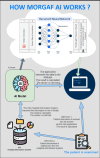Closed circuit artificial ıntelligence model named morgaf for childhood onset systemic lupus erythematosus diagnosis
- PMID: 40595005
- PMCID: PMC12214585
- DOI: 10.1038/s41598-025-92964-z
Closed circuit artificial ıntelligence model named morgaf for childhood onset systemic lupus erythematosus diagnosis
Abstract
Systemic Lupus Erythematosus (SLE) is a chronic, autoimmune disease characterized by multiple organ involvement and autoantibodies, and its diagnosis is not easy in clinical practice. Pediatric SLE (pSLE) is diagnosed using the SLICC 2012 criteria for adult SLE patients. Our study aims to develop a closed computer-based AI model to assist clinicians in diagnosis. Fifty pSLE patients followed up in Hacettepe University Pediatric Rheumatology Outpatient Clinics, and 50 healthy individuals similar to them in terms of age and gender were included in the study. Data sets, including clinical and laboratory findings of the individuals at the time of diagnosis, were given as input to the AI model. Python® software language and Tensorflow® AI library were preferred for model development. The concept of neural networks (NN) is increasingly common in AI studies. Morgaf (the name of the AI model) used the recurrent neural network (RNN) model, which remembers previous inputs during training, leading to lower error rates. Patient data was digitized and used to train the model, which consists of 1024 neurons. The model's error rate decreased from 0.5 to 0.028 during training, leading to successful predictions compared to expert interpretations. Thirty case data (data utterly foreign to the model) were given to Morgaf and simultaneously to expert pediatric rheumatologists, and their interpretations were compared. Prediction success was evaluated by performing regression analyses between both groups. Morgaf accepted 70% and above as a definitive diagnosis of pSLE, averaging 93% (78-98%). It defined 10% and below for a completely healthy case; the average was 1% (0-3%). To recognize diseases requiring follow-up, he set himself a range of 10-70% and estimated the mean to be 33% (15-47%). There was no difference between Morgaf's estimates and actual diagnoses (p = 0.297). Morgaf was 100% successful in recognizing lupus disease. This rate was the same as the diagnostic understanding of clinicians. Morgaf (93.3%) gave more precise recommendations for non-lupus cases than clinicians (70%) (p = 0.034). Regression analysis showed that Morgaf (y = 0.9264xi) was more successful in non-selective prediction than clinicians (y = 0.7322xi). Our study is the first in the literature to develop and test an AI model as a diagnostic tool for pSLE. In this cohort, AI model was at least as successful as pediatric rheumatologists in differentiating pSLE patients from healthy controls and non-pSLE patients. With this study, we have shown that Morgaf may help clinicians with diagnostic and differential diagnoses.
Keywords: Artificial ıntelligence; Diagnosis; Pediatric systemic lupus erythematosus; Recurrent neural network.
© 2025. The Author(s).
Conflict of interest statement
Declarations. Competing interests: The authors declare no competing interests.
Figures




Similar articles
-
Signs and symptoms to determine if a patient presenting in primary care or hospital outpatient settings has COVID-19.Cochrane Database Syst Rev. 2022 May 20;5(5):CD013665. doi: 10.1002/14651858.CD013665.pub3. Cochrane Database Syst Rev. 2022. PMID: 35593186 Free PMC article.
-
Systemic pharmacological treatments for chronic plaque psoriasis: a network meta-analysis.Cochrane Database Syst Rev. 2021 Apr 19;4(4):CD011535. doi: 10.1002/14651858.CD011535.pub4. Cochrane Database Syst Rev. 2021. Update in: Cochrane Database Syst Rev. 2022 May 23;5:CD011535. doi: 10.1002/14651858.CD011535.pub5. PMID: 33871055 Free PMC article. Updated.
-
Systemic pharmacological treatments for chronic plaque psoriasis: a network meta-analysis.Cochrane Database Syst Rev. 2017 Dec 22;12(12):CD011535. doi: 10.1002/14651858.CD011535.pub2. Cochrane Database Syst Rev. 2017. Update in: Cochrane Database Syst Rev. 2020 Jan 9;1:CD011535. doi: 10.1002/14651858.CD011535.pub3. PMID: 29271481 Free PMC article. Updated.
-
Home treatment for mental health problems: a systematic review.Health Technol Assess. 2001;5(15):1-139. doi: 10.3310/hta5150. Health Technol Assess. 2001. PMID: 11532236
-
Cost-effectiveness of using prognostic information to select women with breast cancer for adjuvant systemic therapy.Health Technol Assess. 2006 Sep;10(34):iii-iv, ix-xi, 1-204. doi: 10.3310/hta10340. Health Technol Assess. 2006. PMID: 16959170
References
-
- Kısaarslan, A. P. et al. Neuropsychiatric involvement in juvenile-onset systemic lupus erythematosus: A multicenter study. Joint Bone Spine90(4), 105559 (2023). - PubMed
-
- Aliyev, E. et al. Assessing cognitive functions in non-neuropsychiatric childhood systemic lupus erythematosus: Cross-sectional study. J. Psychosom. Res.189, 112027 (2025). - PubMed
-
- Demirkaya, E. et al. Neuropsychiatric involvement in juvenile systemic lupus erythematosus. Turk. J. Pediatr.50(2), 126 (2008). - PubMed
-
- Widmer, G., Horn, W. & Nagele, B. Automatic knowledge base refinement: learning from examples and deep knowledge in rheumatology. Artif. Intell. Med.5(3), 225–243 (1993). - PubMed
MeSH terms
LinkOut - more resources
Full Text Sources
Medical

